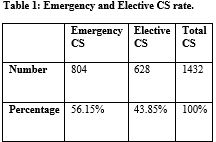“Comparison of Rate and indications of emergency and elective caesarean section: a retrospective Study”
Abstract
Background: Cesarean section remains most commonly performed obstetric surgery and is eitheran emergency or elective procedure. Knowing that always emergency procedure is one that carries agreater risk of complication than an elective procedure, there is a need to compare rate andindications of emergency and elective caesarean section.
Methods: This retrospective study wasconducted at Apollo Institute of Medical Sciences And Research, Chittoor, Andhra Pradesh, India,between Jan 1 2020 – Dec 31 2020. All women who underwent emergency and elective caesareandelivery in OBG department were taken in study.
Results: Total no of caesarean deliveries was1432. Among them, 804 (56.15%) patients had Emergency CS, and 628 (43.85%) had Elective CS.Majority of women were 20 to 30 years old, studied up to metric, residing in a rural area, belongedto middle socioeconomic status and were booked in both Emergency CS and Elective CS groups.Primigravida was more in Emergency CS group, and multigravida were more in Elective CS group.There were statistically significant differences in Age, Education, Residence, Socioeconomic status,Gravida and Booking status between Emergency CS group and Elective CS group (p < 0.05). Fetaldistress was commonest indication for Emergency CS, were as Previous CS was most commonindication for elective CS.
Conclusions: Emergency CS rate is higher when compared to elective CS.Fetal distress is major indication contributing to Emergency CS, and previous CS is major indicationcontributing to Elective CS rate.
Downloads
References
2. Elvedi-Gasparović V, Klepac-Pulanić T, Peter B. Maternal and fetal outcome in elective versus emergency caesarean section in a developing country. Coll Antropol. 2006 Mar;30(1):113-8. PMID: 16617584.
3. Sharma A, Acharya R, Pehal Y, Sharma B. Elective versus emergency caesarean section: differences in maternal outcome. Int J Reprod Contracept Obstet Gynecol 2019;8:3207-12. DOI: 10.18203/2320-1770.ijrcog20193536.
4. Ali M, Hafeez R, Ahmad M. Maternal and fetal outcome; comparison between emergency caesarean section versus elective caesarean section. Prof Med J.2005;12(1):32-9.
5. Toffel S, Placek P, Kosary CVS. Cesarean sections rates 1990: an update. Birth. 1992;19:21-2.
6. Choate JW, Lund CJ. Emergency cesarean section: an analysis of maternal and fetal results in 177 operations. Am J Obstet Gynecol. 1968;100:703-15.
7. Royal College of Obstetricians and Gynaecologists. Classification of urgency of caesarean section: A continuum of risk. From: www.rcog.org.uk/globalassets/documents/guidelines/good practice11classificationofurgency.pdf Accessed: Sep 2015.
8. Benzouina S, Boubkraoui Mel-M, Mrabet M, Chahid N, Kharbach A, El-Hassani A, Barkat A. Fetal outcome in emergency versus elective cesarean sections at Souissi Maternity Hospital, Rabat, Morocco. Pan Afr Med J. 2016 Apr 15;23:197. DOI: 10.11604/pamj.2016.23.197.7401.
9. Darnal N, Dangal G. Maternal and Fetal Outcome in Emergency versus Elective Caesarean Section. J Nepal Health Res Counc. 2020 Sep 7;18(2):186-189. DOI: 10.33314/jnhrc.v18i2.2093.
10. Jain SM, Thool K, Shivkumar PV, Jain MA. Study of sociodemographic factors of women undergoing caesarean section in tertiary care centre of rural area of central India. Int J Reprod Contracept Obstet Gynecol.2019;8:4757-61. DOI: 10.18203/2320-1770.ijrcog20195315.
11. Reddy KM, Sailaja LP, Kodimala SC, Pathakamudi P, Betha K. Prevalence and determinants of caesarean section in a rural tertiary teaching hospital: a 6-year retrospective study. Int J Reprod Contracept Obstet Gynecol.2019;8:560-5. DOI: 10.18203/2320-1770.ijrcog20190284
12. Radha K, Prameela Devi G. and Manjula RV. Study on rising trends of caesarean section (c-section): a bio-sociological effect. IOSR Journal of Dental and Medical Sciences (IOSR-JDMS).2015;14(8):10-13. DOI: 10.9790/0853-14821013.
13. Diema Konlan K, Baku EK, Japiong M, Dodam Konlan K, Amoah RM. Reasons for Women's Choice of Elective Caesarian Section in Duayaw Nkwanta Hospital. J Pregnancy.2019;1-7. DOI: 10.1155/2019/2320743.
14. Kathuria B, Sherin Raj TP. Regional Disparities and Determinants of Caesarean Deliveries in India. Ind J Youth Adol Health.2020;7(4):15-23. DOI: 10.24321/2349.2880.202018.
15. Shrestha A, Shrestha J, Gurung SD. Appraisal of caesarean section incidence and indications at manipal teaching hospital, Pokhara, Nepal. Asian J Med Sci [Internet].2021 Jan;12(1):50-4. DOI: 10.3126/ajms.v12i1.30846.
16. Singh N, Pradeep Y, Jauhari S. Indications and determinants of caesarean section: A cross‑sectional study. Int J App Basic Med Res 2020;10:280-5. DOI:10.4103/ijabmr.IJABMR_3_20.
17. Daniel S, Viswanathan M, Simi BN, Nazeema A. Study of maternal outcome of emergency and elective caesarean section in a semi-rural tertiary hospital. Natl J Med Res.2014;4(1):14-8.
18. Govind L, Rajesh TV. Obstetric outcome in elective vs emergency caesarean section. Indian Journal of Research.2018;7(3):5-6. DOI: 10.36106/PARIPEX.
19. Najam R, Sharma R. Maternal and fetal outcomes in elective and emergency caesarean sections at a teaching hospital in North India: A retrospective study. JARBS. 2013;5(1):5-9.
20. Daniel CN, Singh S. Caesarean delivery: An experience from a tertiary institution in north western Nigeria. Niger J Clin Pract. 2016 Jan-Feb;19(1):18-24. DOI: 10.4103/1119-3077.164350.
21. Soren R, Maitra N, Patel PK, Sheth T. Elective Versus Emergency Caesarean Section: Maternal Complications and Neonatal Outcomes. IOSR Journal of Nursing and Health Science.2016;5(5):01-04. DOI: 10.9790/1959-0505080104.
22. Thakur V, Chiheriya H , Thakur A, Mourya S. Study of maternal and fetal outcome in elective and emergency caesarean section. Int J Med Res Rev.2015;3(11):1300-5. DOI: 10.17511/IJMRR.2015.I11.236.

Copyright (c) 2022 Author (s). Published by Siddharth Health Research and Social Welfare Society

This work is licensed under a Creative Commons Attribution 4.0 International License.


 OAI - Open Archives Initiative
OAI - Open Archives Initiative



















 Therapoid
Therapoid

